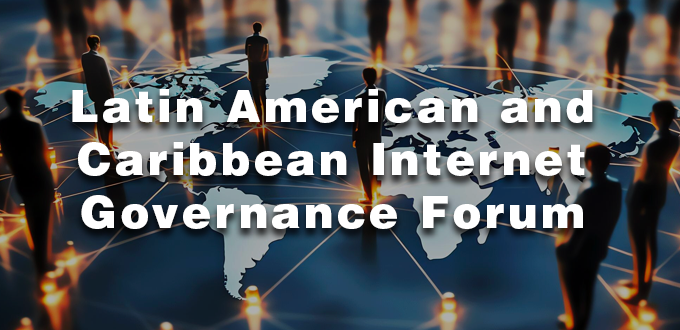LACIGF 2023: Addressing Challenges and Issues on Internet Governance in the Region
20/12/2023

The Externado University of Colombia in Bogota hosted the sixteenth edition of the Latin American and Caribbean Internet Governance Forum (LACIGF). The event, which brought together various stakeholders from the region for an open and productive dialogue on Internet Governance issues, involved more than 50 panelists and moderators from different sectors, along with 170 in-person participants.
During the first day, Paula Oteguy, Multi-stakeholder Engagement Coordinator, and Alessia Zucchetti, Research and Cooperation Projects Coordinator, with the support of César Díaz and Miguel Ignacio Estrada, organized the panel “Opportunities for Support to Address Internet Development Challenges.” The panel aimed to approach regional challenges in strengthening the Internet by gathering insights from experts and beneficiaries involved in some of the key programs and opportunities offered by LACNIC, such as the Líderes Program and the FRIDA Program.
During the panel “The Contribution of NRIs to the Global Digital Compact to be Discussed at the Summit of the Future,” Oteguy shared insights from the recent IGF held in Uruguay on November 22 at La Casa de Internet. The local community engaged in discussions on advanced technologies and accessibility, with a particular focus on AI and the digital divide.
In relation to the challenges and opportunities associated with NRIs, Oteguy focused on the importance of prioritizing meaningful engagement across all sectors. She highlighted the need to secure the required funds to support nationwide initiatives that foster knowledge creation with a local perspective. This approach ensures a diverse range of voices and viewpoints. “These spaces enable to exchange experiences and participate in discussions on topics of mutual interest, creating opportunities for coordination and collaboration among local stakeholders and NRIs. The ongoing effort to achieve a more extensive dialogue with the involvement of every actor and sector within the Internet ecosystem remains a crucial aspect. “There is a need for greater involvement at the level of the IGFs,” she emphasized. In this regard, she extended an invitation to all those interested in Internet Governance issues to familiarize themselves with the LACIGF process and actively engage in it.
During the session “Policies and Initiatives for the Universalization of Access and the Promotion of Digital Talent and Skills – Inclusion and Digital Divide,” moderated by Pablo García de Castro Regional Director at ASIET and César Díaz, Head of Telecommunications Affairs at LACNIC, Lucas Gallitto, Head of Latin America at GSMA shared statistics on the digital divide in the region. Although 63% of individuals in Latin America have access to the Internet, 7% still do not have coverage for mobile broadband. Meanwhile, 30% have access to the Internet but choose not to use it due to a lack of digital skills, the absence of relevant local content in their language, or insufficient resources to access devices.
Furthermore, he referred to Universal Service Funds (USF) and pointed out that, despite examples from countries like Brazil or Colombia, they have not proven to be efficient and require “urgent reforms” in their financing model, the selection and execution of investments, as well as the evaluation of final project outcomes.
Cinthya Arias from Sutel (Costa Rica) discussed the scope of the National Telecommunications Fund (FONATEL), which aims to provide telephone and Internet services to areas and communities where there is currently no coverage through five programs. These programs involve establishing telecommunications infrastructure in remote areas, providing equipment and computers to low-income families, and offering free Internet services to Health Centers, Smart Community Centers, Schools, and Public Colleges. Arias highlighted that they also offer free Internet access points in parks, squares, train stations, and public libraries across the country.
(Free access, no subscription required)
Olga Paz from Colnodo (Colombia) addressed the diversity of gaps, emphasizing that 40% of women in the region do not connect to the Internet. This is especially pronounced in rural areas, where only 28% of the population is connected. She also stressed that it is the right time to tackle these gaps through innovative, inclusive, and participatory models, empowering communities to decide the type of connectivity, model, and format they prefer. Additionally, she highlighted the importance of understanding the adoption of ICTs across various contexts and promoting a critical use of the Internet. This could, for instance, involve the economic inclusion of women or the development of content and narratives in local languages.
Christian O’Flaherty from the Internet Society noted that access gaps are “a shared concern for all stakeholders, particularly governments”. He underscored the importance of optimizing spectrum to provide coverage to underserved areas, rather than using it as a revenue-generating tool. He added that innovative formats should include actors who are often “invisible” but play a crucial role in connecting marginalized populations. He also mentioned the need to “simplify the deployment of infrastructure,” reinforcing that technological changes, such as low-cost and easily deployable passive optical fiber networks, will help reduce the gaps.
During the panel on “Cybersecurity, Cybercrime, and Online Security,” led by César Díaz from LACNIC and Lia Hernández from IPANDETEC (online), Michele Bordachar from Chile’s National Cybersecurity Coordination emphasized the importance of disseminating information about cybersecurity, the various types of attacks and formats. It is crucial for countries to “share this information, along with best practices, lessons, and mistakes,” emphasizing the importance of consistently reporting attacks in both public and private domains.